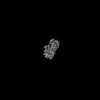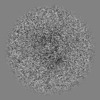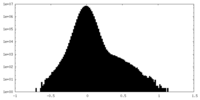[English] 日本語
 Yorodumi
Yorodumi- EMDB-44945: 5HT2AR-miniGq heterotrimer in complex with a novel agonist obtain... -
+ Open data
Open data
- Basic information
Basic information
| Entry |  | |||||||||
|---|---|---|---|---|---|---|---|---|---|---|
| Title | 5HT2AR-miniGq heterotrimer in complex with a novel agonist obtained from large scale docking local map | |||||||||
 Map data Map data | ||||||||||
 Sample Sample |
| |||||||||
 Keywords Keywords | active state GPCR / heterotrimer / complex / serotonin / MEMBRANE PROTEIN | |||||||||
| Biological species |  Homo sapiens (human) Homo sapiens (human) | |||||||||
| Method | single particle reconstruction / cryo EM / Resolution: 2.9 Å | |||||||||
 Authors Authors | Gumpper RH / Wang L / Kapolka N / Skiniotis G / Roth BL | |||||||||
| Funding support |  United States, 1 items United States, 1 items
| |||||||||
 Citation Citation |  Journal: Science / Year: 2024 Journal: Science / Year: 2024Title: AlphaFold2 structures guide prospective ligand discovery. Authors: Jiankun Lyu / Nicholas Kapolka / Ryan Gumpper / Assaf Alon / Liang Wang / Manish K Jain / Ximena Barros-Álvarez / Kensuke Sakamoto / Yoojoong Kim / Jeffrey DiBerto / Kuglae Kim / Isabella S ...Authors: Jiankun Lyu / Nicholas Kapolka / Ryan Gumpper / Assaf Alon / Liang Wang / Manish K Jain / Ximena Barros-Álvarez / Kensuke Sakamoto / Yoojoong Kim / Jeffrey DiBerto / Kuglae Kim / Isabella S Glenn / Tia A Tummino / Sijie Huang / John J Irwin / Olga O Tarkhanova / Yurii Moroz / Georgios Skiniotis / Andrew C Kruse / Brian K Shoichet / Bryan L Roth /   Abstract: AlphaFold2 (AF2) models have had wide impact but mixed success in retrospective ligand recognition. We prospectively docked large libraries against unrefined AF2 models of the σ and serotonin 2A (5- ...AlphaFold2 (AF2) models have had wide impact but mixed success in retrospective ligand recognition. We prospectively docked large libraries against unrefined AF2 models of the σ and serotonin 2A (5-HT2A) receptors, testing hundreds of new molecules and comparing results with those obtained from docking against the experimental structures. Hit rates were high and similar for the experimental and AF2 structures, as were affinities. Success in docking against the AF2 models was achieved despite differences between orthosteric residue conformations in the AF2 models and the experimental structures. Determination of the cryo-electron microscopy structure for one of the more potent 5-HT2A ligands from the AF2 docking revealed residue accommodations that resembled the AF2 prediction. AF2 models may sample conformations that differ from experimental structures but remain low energy and relevant for ligand discovery, extending the domain of structure-based drug design. | |||||||||
| History |
|
- Structure visualization
Structure visualization
| Supplemental images |
|---|
- Downloads & links
Downloads & links
-EMDB archive
| Map data |  emd_44945.map.gz emd_44945.map.gz | 230.1 MB |  EMDB map data format EMDB map data format | |
|---|---|---|---|---|
| Header (meta data) |  emd-44945-v30.xml emd-44945-v30.xml emd-44945.xml emd-44945.xml | 14 KB 14 KB | Display Display |  EMDB header EMDB header |
| Images |  emd_44945.png emd_44945.png | 34.7 KB | ||
| Filedesc metadata |  emd-44945.cif.gz emd-44945.cif.gz | 4.2 KB | ||
| Others |  emd_44945_half_map_1.map.gz emd_44945_half_map_1.map.gz emd_44945_half_map_2.map.gz emd_44945_half_map_2.map.gz | 226.2 MB 226.2 MB | ||
| Archive directory |  http://ftp.pdbj.org/pub/emdb/structures/EMD-44945 http://ftp.pdbj.org/pub/emdb/structures/EMD-44945 ftp://ftp.pdbj.org/pub/emdb/structures/EMD-44945 ftp://ftp.pdbj.org/pub/emdb/structures/EMD-44945 | HTTPS FTP |
-Validation report
| Summary document |  emd_44945_validation.pdf.gz emd_44945_validation.pdf.gz | 1 MB | Display |  EMDB validaton report EMDB validaton report |
|---|---|---|---|---|
| Full document |  emd_44945_full_validation.pdf.gz emd_44945_full_validation.pdf.gz | 1 MB | Display | |
| Data in XML |  emd_44945_validation.xml.gz emd_44945_validation.xml.gz | 15.9 KB | Display | |
| Data in CIF |  emd_44945_validation.cif.gz emd_44945_validation.cif.gz | 18.9 KB | Display | |
| Arichive directory |  https://ftp.pdbj.org/pub/emdb/validation_reports/EMD-44945 https://ftp.pdbj.org/pub/emdb/validation_reports/EMD-44945 ftp://ftp.pdbj.org/pub/emdb/validation_reports/EMD-44945 ftp://ftp.pdbj.org/pub/emdb/validation_reports/EMD-44945 | HTTPS FTP |
-Related structure data
- Links
Links
| EMDB pages |  EMDB (EBI/PDBe) / EMDB (EBI/PDBe) /  EMDataResource EMDataResource |
|---|
- Map
Map
| File |  Download / File: emd_44945.map.gz / Format: CCP4 / Size: 244.1 MB / Type: IMAGE STORED AS FLOATING POINT NUMBER (4 BYTES) Download / File: emd_44945.map.gz / Format: CCP4 / Size: 244.1 MB / Type: IMAGE STORED AS FLOATING POINT NUMBER (4 BYTES) | ||||||||||||||||||||||||||||||||||||
|---|---|---|---|---|---|---|---|---|---|---|---|---|---|---|---|---|---|---|---|---|---|---|---|---|---|---|---|---|---|---|---|---|---|---|---|---|---|
| Projections & slices | Image control
Images are generated by Spider. | ||||||||||||||||||||||||||||||||||||
| Voxel size | X=Y=Z: 0.868 Å | ||||||||||||||||||||||||||||||||||||
| Density |
| ||||||||||||||||||||||||||||||||||||
| Symmetry | Space group: 1 | ||||||||||||||||||||||||||||||||||||
| Details | EMDB XML:
|
-Supplemental data
-Half map: #1
| File | emd_44945_half_map_1.map | ||||||||||||
|---|---|---|---|---|---|---|---|---|---|---|---|---|---|
| Projections & Slices |
| ||||||||||||
| Density Histograms |
-Half map: #2
| File | emd_44945_half_map_2.map | ||||||||||||
|---|---|---|---|---|---|---|---|---|---|---|---|---|---|
| Projections & Slices |
| ||||||||||||
| Density Histograms |
- Sample components
Sample components
-Entire : Active state complex of 5HT2AR with mini-Gq heterotrimer stabiliz...
| Entire | Name: Active state complex of 5HT2AR with mini-Gq heterotrimer stabilized by scFv16 |
|---|---|
| Components |
|
-Supramolecule #1: Active state complex of 5HT2AR with mini-Gq heterotrimer stabiliz...
| Supramolecule | Name: Active state complex of 5HT2AR with mini-Gq heterotrimer stabilized by scFv16 type: complex / ID: 1 / Parent: 0 / Macromolecule list: #1-#5 |
|---|---|
| Source (natural) | Organism:  Homo sapiens (human) Homo sapiens (human) |
-Experimental details
-Structure determination
| Method | cryo EM |
|---|---|
 Processing Processing | single particle reconstruction |
| Aggregation state | particle |
- Sample preparation
Sample preparation
| Buffer | pH: 7.4 |
|---|---|
| Vitrification | Cryogen name: ETHANE-PROPANE |
- Electron microscopy
Electron microscopy
| Microscope | FEI TITAN KRIOS |
|---|---|
| Image recording | Film or detector model: GATAN K3 (6k x 4k) / Average electron dose: 50.0 e/Å2 |
| Electron beam | Acceleration voltage: 300 kV / Electron source:  FIELD EMISSION GUN FIELD EMISSION GUN |
| Electron optics | Illumination mode: OTHER / Imaging mode: OTHER / Nominal defocus max: 20.0 µm / Nominal defocus min: 5.0 µm |
| Experimental equipment |  Model: Titan Krios / Image courtesy: FEI Company |
 Movie
Movie Controller
Controller









 Z (Sec.)
Z (Sec.) Y (Row.)
Y (Row.) X (Col.)
X (Col.)





































